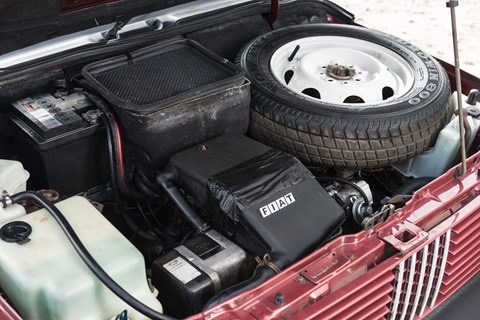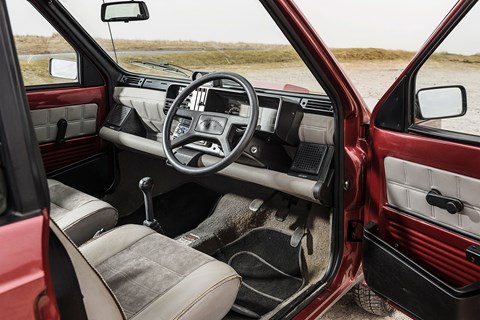We motoring journalists love our ‘old versus new’ comparisons, yet where’s the current Panda 4×4 to sit alongside the original in this test? Well, that’s not the story here. Rather, I’m more interested in seeing just how far Fiat has come since it built that iconic four-wheel-drive runabout in the ’80s and, by way of comparison, whether the pseudo-4×4 Fiat 500X I drive on a daily basis is all show and no go.
But a little history first. The Panda went on sale in 1980, and as was (and is) the Fiat way, offered a cheap, no-frills set of wheels to move the Italian masses, with practical touches such as washable seat covers wrapped up in some rather neat Giorgetto Giugiaro-penned lines.
The Panda 4×4 that followed in 1983 was a bit of an oddity. Who’d want such a small car with four-wheel drive? Actually, anyone who lived within sight of the Alps. And with everything in the drivetrain from the clutch backwards supplied from across the border by Austrian firm Steyr-Puch, and skinny little 145-section tyres wrapping the four driven wheels, it tackled snow, mud, and whatever else its owners threw at it with absolute aplomb.

The rest of the Panda range received a substantial overhaul in 1986, but while the Panda 4×4 was treated to some of those enhancements (like the rather useful fully galvanised body…) it made do without the new engines, gearboxes and suspension so the trusted four-wheel drive hardware could be left well alone.
Why change a winning recipe? Whether you were a farmer or a postman or just someone who needed to get around when the weather got grim, the Panda 4×4 was the perfect tool for the job. These little cars have cult status in the Alps – and appeal further afield – and many still survive today. Heck, I once went on a launch of an SUV, and our convoy of press cars were led up a rough track into the mountains by a local guide in her Panda 4×4.
Which brings us to this, the Sisley special edition, which is lined up alongside my long-termer in the Brecon Beacons. Originally launched in 1987 as a limited-run model, the Sisley’s popularity meant it soon became a permanent fixture within Fiat’s pricelist – though it’s still more sought after than regular Panda 4x4s.

What makes a Sisley a Sisley? If you’re an off-road enthusiast it’s the headlamp washers, inclinometer, bonnet vent and – where fitted – the roof rack and front and rear bull bars (the latter able to fold down to give access to the boot). Or if you’re more into your fashion (and the Sisley was a collaboration with one of Benetton’s clothing companies) then it’s all about the white wheels, ribbed seats, and plethora of canoe badges.
So, off-roading then… Alas not today. And before you write in/post on Facebook/Snapchat the editor/communicate via some other method I’m too old to understand (and Snapchat is already a stretch…) let me explain why this isn’t a thorough road test. There appear to be two types of Panda 4×4 in the UK: those with a little, ahem, patina, and others, like this one, that are rather too nice to be driven into the countryside.
In fact, Marpol Vehicles in south Wales, who we borrowed this car from, have another Panda 4×4 in stock and having rebuilt it to concours spec won’t even let it out when there’s a cloud in the sky. (Would you be surprised to hear that the two brothers who run the company have family roots in northern Italy? They have a rather nice Ferrari 308 GTB up for sale too…)
Essentially then, I could have found and driven a rusty Panda 4×4 and tried to get it stuck in the mud, or taken out a mint one like this for some good, clean fun. I chose the latter, and as the thick mist that inevitably draws in around us gradually burns off, it reveals itself to be a cool little box of maroon loveliness.
I don’t know where to start: crawl underneath and prod the chunky drivetrain like I know what I’m talking about? Pop the bonnet and marvel at how the spare wheel sits atop the diddy 999cc engine? No, instead I start blabbering on about how refreshing it is to see a car with body cladding. Remember that? Where if you dinged a door you replaced a bit of plastic trim rather than an entire panel? Get out more? Yeah…

Inside I’m equally drawn to odd observations. Like the fact the door is just a door, with a simple oblong piece of trim affixed to the upper half, plus a pocket, handle and window winder screwed straight into the metal. No swooping plastic mouldings butting up flush with the dashboard, no padded leather armrests, no in-built airbags, no switches to control the central locking, all-round electric windows and folding mirrors. No wonder, even with the four-wheel-drive hardware, the Panda 4×4 weighs a paltry 790kg.
Eventually I become slightly more astute and get onto the business of that four-wheel-drive system. There are no open diffs acted upon by ESC electronics here, no dial to be turned or buttons pressed to tell multiple ECUs what to do with the throttle, engine and brakes. Nope, instead you read the oh-so-simple instructions on a metal panel riveted onto the transmission tunnel, yank up the stubby little handle behind the gearstick, and you’re good to go. Albeit only up to 38mph.
What’s the system like? Well, given it wasn’t wet and the Panda 4×4 doesn’t have the grunt to trouble its tyres (49bhp, 0-62mph in 17.5 seconds) there are few conclusion to be legitimately drawn. And being an old car driven in the context of a modern-day alternative, the experience behind the wheel is everything you’d expect: visibility is great but the brakes aren’t, the ride quality comes from an era when engineers still held sway over designers, hefting the steering about comes as a shock to arms used to power assistance, and with the 500X following along behind for photography, it feels like you’re being stalked by some whopping great white predator.
All of which means I come away from this encounter with an appreciation of the Panda 4×4 for what it is, rather than what it can do. (Which seems rather ironic given that’s exactly what the modern SUV, in all its guises, is criticised for – the 500X included.) Whichever way you take it though, the Panda 4×4 is an object of retro, minimalist desire.
The 500X? The fact I haven’t mentioned it since the start does it a disservice, because climbing back aboard to face the four-hour journey home, turning on the heated seats, turning up the DAB radio, settling into comfortable leather seats and setting the cruise control, it’s everything the car of today needs to be and everything the Panda 4×4 can’t be. It can’t go off-road like the Panda 4×4, it won’t have cult status in 30 years, but right now it’s a rather decent little car.
So after all that, there’s really no link to be made from that early Fiat four-wheel drive vehicle to its latest SUV, but that doesn’t mean they don’t both conform to Fiat’s proletarian heritage. They do, and I rather like both of them.
The four-wheel drive Fiat 500X you’ll never need
The 500X is two-wheel drive as standard, but if you opt for a Cross-spec model like mine (or the plusher Cross Plus) one of the additions besides the chunkier bodykit is the Traction+ system. It uses a bit of electronic trickery with the front brakes to mimic a locking differential, but I’ve yet to need to twiddle the dial between the front seats from Auto to Traction. So unless you do live in the Alps and need to replace your Panda 4×4, there’s no need for the four-wheel-drive version. Like the cigar you never light then, the 500X is all about the look.
Logbook: Fiat 500X 1.6 MultiJet Cross
Engine 1598cc 16v turbodiesel 4-cyl, 118bhp @ 3750rpm, 236lb ft @ 1750rpm
Transmission 6-speed manual, front-wheel drive
Stats 10.5sec 0-62mph, 115mph, 109g/km
Price £20,095
As tested £24,320
Miles this month 497
Total miles 7914
Our mpg 34.7
Official mpg 68.9
Fuel this month £61.95
Extra costs £0
Read more from the June 2016 issue of CAR magazine
